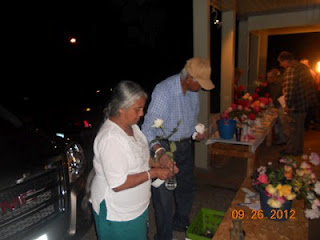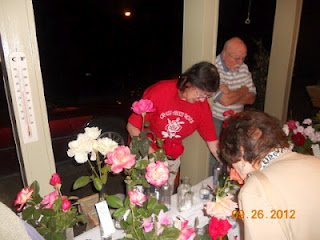This might be of interest to you rose wranglers out there. I've begun using 2 products, mixed together in one "solution", to spray my roses. The products are GreenCure (also marketed as MilStop) and Miracle-Gro Bloom Booster. I'll leave it as an exercise for the reader to research the products on the web. Around here, I've found Miracle-Gro Bloom Booster in 15-30-15 concentration and in 10-52-10 concentration (available at 13th Street Nursery). I prefer the 10-52-10 concentration, because phosphorus is what I want. It really takes a while for soil to warm up here in the Northwest, and the literature I've read indicates that phosphorus uptake by plants (roses) is pretty limited at soil temperatures below 55 degrees. After seeing my roses at different times last year, Maryann suggested that maybe a phosphorus deficiency was causing the foliage spotting on my roses. I had been using MilStop (aka GreenCure) throughout the last 2 growing seasons, but our cold soil was preventing it from being the absolute one-stop spray mix for the Northwest.
MilStop/GreenCure is pretty good stuff. It is 85 percent potassium bicarbonate and 15 percent "other ingredients'', which I presume is the built in spreader/sticker -- surfactants. Although the manufacturer suggests that we shouldn't mix anything else with their product, I do it anyway. The "solution" then will be 1 tablespoon of GreenCure plus one tablespoon of Miracle-Gro 10-52-10 in a one gallon sprayer. Both products are very soluble in cold water. Since potassium bicarbonate is 39 percent potassium, then MilStop/GreenCure would be .85 x .39 = 33 percent potassium. Add it to the 10-52-10 and we get 10-52-43 as the final NPK values. I started using the COMBINED mixture (once per week) during the second half of last year's growing season with very favorable results. I applied it even on hot days, and there was no leaf burn. This year, I've already started spraying in February using the combined mixture. I'll keep you posted about my cold-season results. Bottom line: roses really love foliar feeding, and this mixture is super food. And, compared to other rose sprays out there, this mixture should rank extremely low on the toxicity scale.
Update of May 17, 2012: I'm still very pleased with the above mixture. However, my roses that are last in line to get morning sun are still being plagued by some weird spotting. Besides the reduced sun exposure, this could be due to the fact that the affected rose bushes are seedlings, and that their roots haven't kept pace with above-ground cane growth. However, the seedlings that get early sun are doing VERY well. Looking at the photos below, this would include those rose bushes in full sun by around 8:30 am.
ROSE ADVISORY: Plant your roses where they will be in full sun by 8:30 am.
Here's a photo of the weird spotting as seen today:
And here's a time-series of photos from this morning. The shade is provided courtesy of the trees to the east of the rose bed (behind the shed) and courtesy of the shed itself.
 |
| 8:40 am |
 |
| 9:20 am |
 |
| 9:40 am |
 |
| 9:55 am |


































